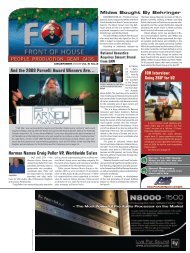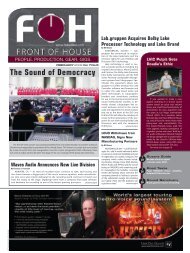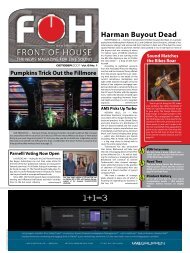Create successful ePaper yourself
Turn your PDF publications into a flip-book with our unique Google optimized e-Paper software.
By JamieRio Heavenly<br />
Over the last two months, we have<br />
spent time exploring the variety of<br />
microphones and the importance of<br />
having your ears as sharp as possible. This<br />
month, I would like to talk about basic stage<br />
setups and EQ scenarios. I know a lot of you<br />
have a basic idea of how to make your pastor,<br />
choir or worship band sound good. However,<br />
some of you don't, and we can always use a<br />
little tune-up, especially me. So, here we go.<br />
Listen To What the Man Says ss<br />
I think we can all agree that the words<br />
that pour out of the mouths of our pastors,<br />
priests, rabbis or whoever our worship orator<br />
happens to be is ultimately the most important<br />
part of the service. We will call the person<br />
talking about God the preacher to simplify<br />
our discussion. Your preacher either stands<br />
behind a podium or pulpit or travels freely<br />
about the stage delivering the word. Whether<br />
the preacher prefers a wired or wireless mic<br />
makes no difference. We are only interested<br />
in how clear and natural he or she sounds.<br />
If you have time before a service, it's a very<br />
good idea to test the microphone that your<br />
preacher will be using — even better if you<br />
have an assistant on stage so you can remain<br />
at the mixing board. Start with your EQ flat<br />
and have your assistant talk boldly into the<br />
preacher's mic. Bring up the gain until your<br />
meters (LEDs) are in the yellow zone. If your<br />
board only has LEDs that show "signal present"<br />
and "too hot,” push the gain until you<br />
are too hot then back it off a ¼-turn. If your<br />
preacher has dynamic vocals, it would be nice<br />
if you had a compressor or limiter to handle<br />
the potential peaks. If you don't, just back the<br />
gain off a bit and plan on riding your channel<br />
fader during the message part of the service.<br />
Sound Sanctuary<br />
Mixing<br />
Now there is no reason for you to put the<br />
preachers' voice in the stage monitors unless<br />
it is specifically requested. You have good<br />
signal strength from the microphone, so just<br />
listen as your assistant talks and talks. Do you<br />
hear any boominess? If you do, engage your<br />
high-pass button or cut your low-EQ knob.<br />
Subtle adjustments always seem to work better<br />
than cranking the knobs up or down. Is<br />
the voice sounding natural? 315 Hz to 600 Hz<br />
is important for a smooth, natural voice. Cut<br />
or boost in this area; if your board does not<br />
have a sweepable mid EQ, try slightly increasing<br />
or decreasing the mid-frequency knob.<br />
Listen again to your assistant's voice. If the<br />
voice sounds harsh than the problem may reside<br />
in the 2 kHz to 4 kHz range.<br />
Whether the preacher prefers a wired<br />
or wireless mic makes no difference.<br />
We are only interested in how clear and<br />
natural he or she sounds.<br />
N<br />
These frequencies also cause ear fatigue<br />
so you don't want your preacher slamming<br />
the congregation with them. On the other<br />
hand, intelligibility also lives in these frequencies.<br />
Therefore, it is a bit of a balancing act. So,<br />
once again, listen closely. The spoken word<br />
can produce harmonics up to 8 kHz. Boosting<br />
those up can add some sparkle as long as you<br />
don't create a brittle sound with your EQ. By<br />
the way, if you don't have an assistant, plug<br />
your preacher's mic into your board and test<br />
it yourself.<br />
Preaching to the Choir ss<br />
Your choir’s voices follow the same audio<br />
rules as your preacher. The only difference is<br />
that there are more people and they are all<br />
singing. Let's say you have a dozen members<br />
in your choir: If your house has installed choir<br />
mics (generally hanging from the ceiling), I<br />
like to position the choir so the mics are two<br />
feet in front of the singers and about two feet<br />
above their heads. Same distances if you use<br />
Optimization of<br />
High-Frequency<br />
Drivers<br />
As an owner/operator of a sound company, you<br />
need to be given the knowledge to shop-tweak<br />
the rigs you own to optimum flatness before your<br />
customer/guest engineers mess with the equalizer.<br />
And nothing repels a guest engineer from the <strong>FOH</strong><br />
equalizer more than a great sounding rig at the<br />
<strong>FOH</strong> position. But the crucial system setup aspect<br />
is getting the 1 kHz and up, high-frequency filtering<br />
perfect before hand.<br />
— Mark Amundson from his “Theory and Practice”<br />
column in the July 2008 issue.<br />
www.fohonline.com<br />
mics and stands for your singers. Two good<br />
condenser microphones will work well, or use<br />
four if you want to mic the individual vocal<br />
groups (bass, tenor, altos and sopranos).<br />
If you have condenser mics, that's good.<br />
Mainly because this type of mic is ideal for<br />
hearing a sound sources from a distance and<br />
is more sensitive than a dynamic mic. Did I<br />
mention that your microphones hear? It's<br />
good to think of them in this manner. Knowing<br />
how a mic hears can help you with proper<br />
positioning and, of course, using the right<br />
mic. The reality, however, it that you will be<br />
using whatever mics and configuration that<br />
your house has. Now, set up your microphones<br />
and bring up the gain. It's the same<br />
drill friends — flat EQ and signal strength<br />
in the yellow. Before you reach for the EQ<br />
knobs, listen to the singers. Sometimes just<br />
moving your microphones around can help<br />
with the overall blend and smoothness of<br />
the voices.<br />
Tenors, Altos and Sopranos, Oh My! SS<br />
With your mics set in the optimum positions,<br />
you can begin adjusting EQ as needed.<br />
Bass and tenor frequency fundamentals lie<br />
in the 160 Hz to 250 Hz range and altos and<br />
sopranos in 315 Hz to 500 Hz. As I mentioned<br />
before, 600 Hz to 1K is important for the natural<br />
sound of your vocalist. 630 Hz is represented<br />
by a slider on all 1 /3-octave graphic EQs. So,<br />
if your house of worship is heavy on singing,<br />
this is a frequency that can be very important<br />
in the overall tuning of your worship space.<br />
Your choir will probably have some sort<br />
of stage monitors. Be careful of feedback in<br />
the 1 K to 4 K area. Keep in mind that these<br />
same frequencies greatly affect intelligibility<br />
and also are responsible for ear fatigue. Actually<br />
there is a lot going on in this range. I suggest<br />
you listen carefully and adjust sparingly<br />
throughout this frequency band. Occasionally,<br />
I will boost a bit the 10 K to 12 K range.<br />
This can add "air" to the choir, but it also can<br />
add noise. As always, use your ears (twice).<br />
I realize that I haven't gotten to the miking<br />
and EQing of the worship band and all the<br />
instruments that can entail. But worry not,<br />
next month I will be tackling that sometimes<br />
difficult subject. I will get into topics from<br />
drums to flutes and everything in between —<br />
not to mention the politics and etiquette of<br />
your average worship band.<br />
Contact Jamie at jrio@fohonline.com.<br />
2008 AUGUST<br />
37<br />
Ad info:http:// foh.hotims.com

















